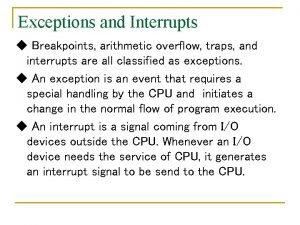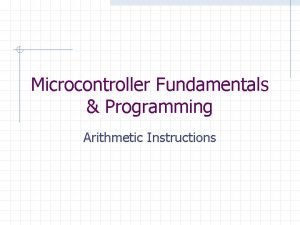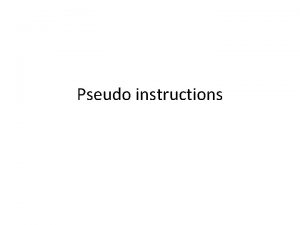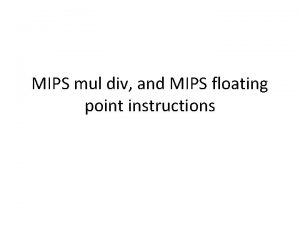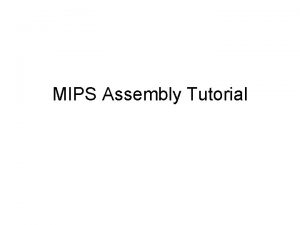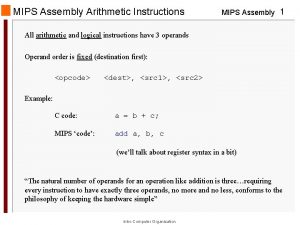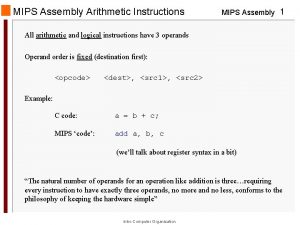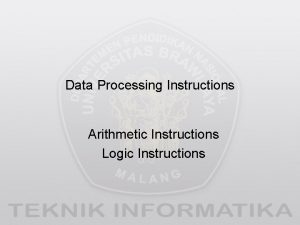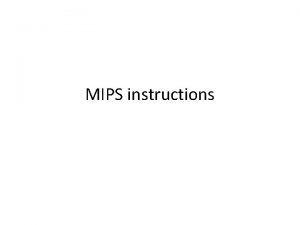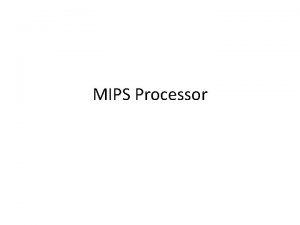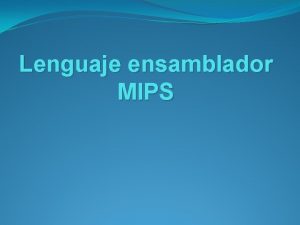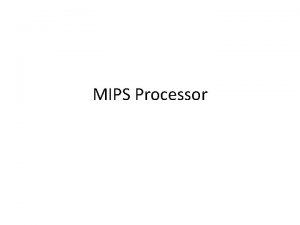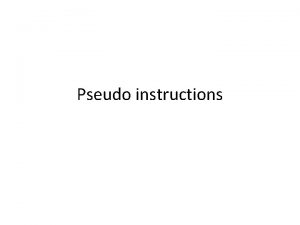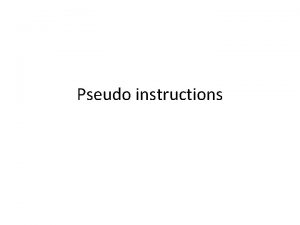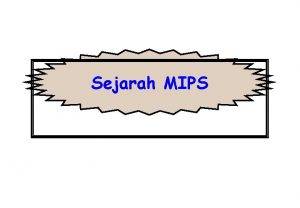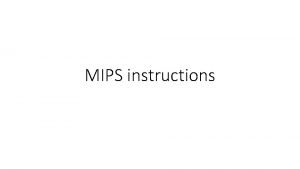MIPS arithmetic n n All instructions have 3



![Instructions n n Load and store instructions Example: C code: A[8] = h + Instructions n n Load and store instructions Example: C code: A[8] = h +](https://slidetodoc.com/presentation_image_h/8fdf9ac7923ad30ee28786d09870cd96/image-4.jpg)
![Our First Example n Can we figure out the code? swap(int v[], int k); Our First Example n Can we figure out the code? swap(int v[], int k);](https://slidetodoc.com/presentation_image_h/8fdf9ac7923ad30ee28786d09870cd96/image-5.jpg)













![Power. PC n Indexed addressing n n n #$t 1=Memory[$a 0+$s 3] Update addressing Power. PC n Indexed addressing n n n #$t 1=Memory[$a 0+$s 3] Update addressing](https://slidetodoc.com/presentation_image_h/8fdf9ac7923ad30ee28786d09870cd96/image-19.jpg)


- Slides: 21

MIPS arithmetic n n All instructions have 3 operands Operand order is fixed (destination first) Example: C code: A = B + C MIPS code: add $s 0, $s 1, $s 2 (associated with variables by compiler) Ó 1998 Morgan Kaufmann Publishers

MIPS arithmetic n n Design Principle: simplicity favours regularity. Of course this complicates some things. . . C code: Why? A = B + C + D; E = F - A; MIPS code: add $t 0, $s 1, $s 2 add $s 0, $t 0, $s 3 sub $s 4, $s 5, $s 0 n n Operands must be registers, only 32 registers provided Design Principle: smaller is faster. Why? Ó 1998 Morgan Kaufmann Publishers

Registers vs. Memory n n n Arithmetic instructions operands must be registers, — only 32 registers provided Compiler associates variables with registers What about programs with lots of variables Control Input Memory Datapath Processor Output I/O Ó 1998 Morgan Kaufmann Publishers
![Instructions n n Load and store instructions Example C code A8 h Instructions n n Load and store instructions Example: C code: A[8] = h +](https://slidetodoc.com/presentation_image_h/8fdf9ac7923ad30ee28786d09870cd96/image-4.jpg)
Instructions n n Load and store instructions Example: C code: A[8] = h + A[8]; MIPS code: lw $t 0, 32($s 3) add $t 0, $s 2, $t 0 sw $t 0, 32($s 3) n n Store word has destination last Remember arithmetic operands are registers, not memory! Ó 1998 Morgan Kaufmann Publishers
![Our First Example n Can we figure out the code swapint v int k Our First Example n Can we figure out the code? swap(int v[], int k);](https://slidetodoc.com/presentation_image_h/8fdf9ac7923ad30ee28786d09870cd96/image-5.jpg)
Our First Example n Can we figure out the code? swap(int v[], int k); { int temp; temp = v[k] = v[k+1]; v[k+1] = temp; swap: } muli $2, $5, 4 add $2, $4, $2 lw $15, 0($2) lw $16, 4($2) sw $16, 0($2) sw $15, 4($2) jr $31 Ó 1998 Morgan Kaufmann Publishers

Machine Language n Instructions, like registers and words of data, are also 32 bits long n n n Example: add $t 0, $s 1, $s 2 registers have numbers, $t 0=9, $s 1=17, $s 2=18 Instruction Format: 000000 10001 10010 01000 00000 op n rs rt rd 100000 shamt funct Can you guess what the field names stand for? Ó 1998 Morgan Kaufmann Publishers

Machine Language n Consider the load-word and store-word instructions, n n n Introduce a new type of instruction format n n What would the regularity principle have us do? New principle: Good design demands a compromise I-type for data transfer instructions other format was R-type for register Example: lw $t 0, 32($s 2) 35 18 9 op rs rt 32 16 bit number Where's the compromise? Ó 1998 Morgan Kaufmann Publishers

Control n Decision making instructions n n n alter the control flow, i. e. , change the "next" instruction to be executed MIPS conditional branch instructions: bne $t 0, $t 1, Label beq $t 0, $t 1, Label n Example: if (i==j) h = i + j; bne $s 0, $s 1, Label add $s 3, $s 0, $s 1 Label: . . Ó 1998 Morgan Kaufmann Publishers

Control n n MIPS unconditional branch instructions: j label Example: if (i!=j) h=i+j; else h=i-j; n beq $s 4, $s 5, Lab 1 add $s 3, $s 4, $s 5 j Lab 2 Lab 1: sub $s 3, $s 4, $s 5 Lab 2: . . . Can you build a simple for loop? Ó 1998 Morgan Kaufmann Publishers

Control Flow n n We have: beq, bne, what about Branch-if-less-than? New instruction: if $s 1 < $s 2 then $t 0 = 1 slt $t 0, $s 1, $s 2 else $t 0 = 0 Can use this instruction to build "blt $s 1, $s 2, Label" — can now build general control structures Note that the assembler needs a register to do this, — there are policy of use conventions for registers 2 Ó 1998 Morgan Kaufmann Publishers

Policy of Use Conventions Ó 1998 Morgan Kaufmann Publishers

Constants n n Small constants are used quite frequently (50% of operands) e. g. , A = A + 5; B = B + 1; C = C - 18; Solutions? Why not? n n n put 'typical constants' in memory and load them. create hard-wired registers (like $zero) for constants like one. MIPS Instructions: addi $29, 4 slti $8, $18, 10 andi $29, 6 ori $29, 4 n How do we make this work? Ó 1998 Morgan Kaufmann Publishers

How about larger constants? n n We'd like to be able to load a 32 bit constant into a register Must use two instructions, new "load upper immediate" instruction lui $t 0, 1010101010101010 n ori filled with zeros 00000000 Then must get the lower order bits right, i. e. , ori $t 0, 1010101010101010 0000000000000000 1010101010101010 Ó 1998 Morgan Kaufmann Publishers

Assembly Language vs. Machine Language n Assembly provides convenient symbolic representation n Machine language is the underlying reality n n e. g. , destination is no longer first Assembly can provide 'pseudoinstructions' n n n much easier than writing down numbers e. g. , destination first e. g. , “move $t 0, $t 1” exists only in Assembly would be implemented using “add $t 0, $t 1, $zero” When considering performance you should count real instructions Ó 1998 Morgan Kaufmann Publishers

Addresses in Branches n Instructions: bne $t 4, $t 5, Label beq $t 4, $t 5, Label Formats: op n rs rt 16 bit address Could specify a register (like lw and sw) and add it to address n n n Next instruction is at Label if $t 4°$t 5 Next instruction is at Label if $t 4=$t 5 use Instruction Address Register (PC = program counter) most branches are local (principle of locality) Jump instructions just use high order bits of PC n address boundaries of 256 MB Ó 1998 Morgan Kaufmann Publishers

To summarize:

Ó 1998 Morgan Kaufmann Publishers

Alternative Architectures n n Design alternative: n goal is to reduce number of instructions executed n provide more powerful operations n danger is a slower cycle time and/or a higher CPI Sometimes referred to as “RISC vs. CISC” n n n virtually all new instruction sets since 1982 have been RISC VAX: minimize code size, make assembly language easy instructions from 1 to 54 bytes long! We’ll look at Power. PC and 80 x 86 Ó 1998 Morgan Kaufmann Publishers
![Power PC n Indexed addressing n n n t 1Memorya 0s 3 Update addressing Power. PC n Indexed addressing n n n #$t 1=Memory[$a 0+$s 3] Update addressing](https://slidetodoc.com/presentation_image_h/8fdf9ac7923ad30ee28786d09870cd96/image-19.jpg)
Power. PC n Indexed addressing n n n #$t 1=Memory[$a 0+$s 3] Update addressing n n example: lw $t 1, $a 0+$s 3 What do we have to do in MIPS? update a register as part of load (for marching through arrays) example: lwu $t 0, 4($s 3) #$t 0=Memory[$s 3+4]; $s 3=$s 3+4 What do we have to do in MIPS? Others: n n load multiple/store multiple a special counter register “bc Loop” decrement counter, if not 0 goto loop Ó 1998 Morgan Kaufmann Publishers

80 x 86 n n n 1978: The Intel 8086 is announced (16 bit architecture) 1980: The 8087 floating point coprocessor is added 1982: The 80286 increases address space to 24 bits, +instructions 1985: The 80386 extends to 32 bits, new addressing modes 1989 -1995: The 80486, Pentium Pro add a few instructions (mostly designed for higher performance) 1997: MMX is added “This history illustrates the impact of the “golden handcuffs” of compatibility “adding new features as someone might add clothing to a packed bag” Ó 1998 Morgan Kaufmann Publishers “an architecture that is difficult to explain and impossible to love”

A dominant architecture: 80 x 86 n n See your textbook for a more detailed description Complexity: n n n Instructions from 1 to 17 bytes long one operand must act as both a source and destination one operand can come from memory complex addressing modes e. g. , “base or scaled index with 8 or 32 bit displacement” Saving grace: n n the most frequently used instructions are not too difficult to build compilers avoid the portions of the architecture that are slow “what the 80 x 86 lacks in style is made up in quantity, making it beautiful from the right perspective” Ó 1998 Morgan Kaufmann Publishers
 Arithmetic overflow mips
Arithmetic overflow mips Daa instruction in 8051
Daa instruction in 8051 Bclt mips
Bclt mips Mov.s mips
Mov.s mips Mips tutorial
Mips tutorial Li mips instruction
Li mips instruction Draw three noncollinear points j k and l
Draw three noncollinear points j k and l It has 6 square faces 12 edges and vertices
It has 6 square faces 12 edges and vertices Alu in mips
Alu in mips Love ever hurt never
Love ever hurt never Interventi sociali rivolti all'infanzia e all'adolescenza
Interventi sociali rivolti all'infanzia e all'adolescenza Above all powers above all kings
Above all powers above all kings I work all night i work all day to pay the bills
I work all night i work all day to pay the bills Communication operations
Communication operations Sistem all in all out
Sistem all in all out Nodi lymphoidei inguinales profundi
Nodi lymphoidei inguinales profundi Silent night holy night all is calm
Silent night holy night all is calm You are my all in all images
You are my all in all images All of you is more than enough for all of me
All of you is more than enough for all of me She's all states and all princes i
She's all states and all princes i What heights of love what depths of peace
What heights of love what depths of peace Above all powers
Above all powers
